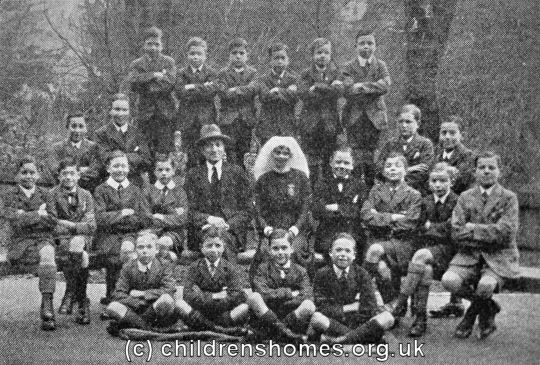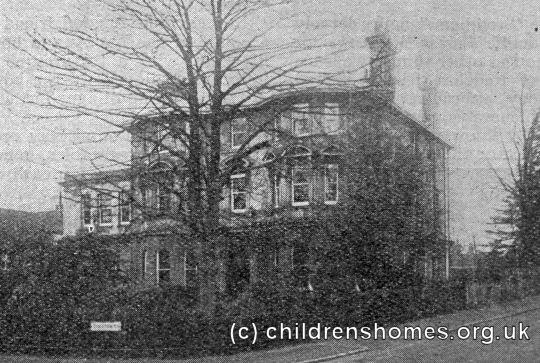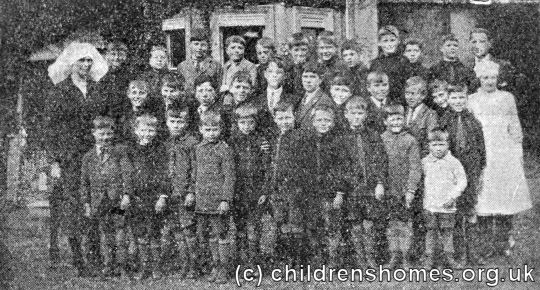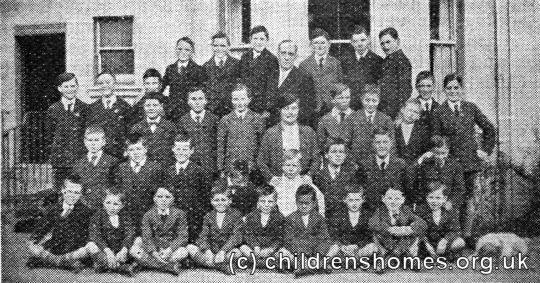St George's Home for Boys, Tunbridge Wells, Kent
In 1905, the Waifs and Strays Society opened the St George's Home for Boys in a leased property at 51 Upper Grosvenor Road, Tunbridge Wells. The home, which could accommodate 27 boys aged from 7 to 12, was dedicated by the Bishop of Rochester on April 26th, 1906. The home's initial intake came largely from the Dover Home for Boys, which was being closed.

St George's Home for Boys, Upper Grosvenor Road, Tunbridge Wells, c.1906. © Peter Higginbotham

St George's Home for Boys, Upper Grosvenor Road, Tunbridge Wells, c.1925. © Peter Higginbotham
When the lease on the Upper Grosvenor Road premises expired in 1926, a replacement house was purchased close by at 7 Chilston Road. The property had previously been a boarding school and had spacious rooms and a large garden. The new premises were formally opened on December 13th, 1927, by Cherry, Lady Poynter, with the Bishop of Rochester performing the ceremony of dedication. Also at the occasion, the Archdeacon of Tonbridge installed the new new Master and Matron, presenting the former with the keys of the home and latter with her badge of office,

St George's Home for Boys, Chilston Road, Tunbridge Wells, c.1927. © Peter Higginbotham

St George's Home for Boys, Chilston Road, Tunbridge Wells, c.1927. © Peter Higginbotham

St George's Home for Boys, Chilston Road, Tunbridge Wells, c.1931. © Peter Higginbotham
Due to the Second World War the children were evacuated to Rock Ferry for part of 1944. St George's Home for Boys closed in 1955, when the need for a boy's home in the area lessened. The Society turned the building into nursery, which eventually closed in 1981.During the Second World War, the home was evacuated to the Rock Ferry home for a period in 1944.
St George's closed as a boys' home in 1955 and was re-opened as nursery which continued operating until 1981. In more recent times, the Chilston building has been home to the St George's Community Children's Project which provides a variety of child care facilities. The Upper Grosvenor Road property is now in private residential use.
Records
Note: many repositories impose a closure period of up to 100 years for records identifying individuals. Before travelling a long distance, always check that the records you want to consult will be available.
- Index of the Society's first 30,000 children's case files ordered by surname.
- Index of the Society's first 30,000 children's case files ordered by date of birth.
- The Children's Society Records and Archive Centre is at Unit 25, Springfield House, 5 Tyssen Street, London E8 2LZ (email: archives@childrenssociety.org.uk). Files for children admitted to its homes after September 1926 were microfilmed in the 1980s and the originals destroyed. Some post-1926 files had already been damaged or destroyed during a flood. The Society's Post-Adoption and Care Service provides access to records, information, advice, birth record counselling, tracing and intermediary service for people who were in care or adopted through the Society.
- The Society has produced detailed catalogues of its records relating to disabled children, and of records relating to the Children's Union (a fundraising body mostly supported from the contributions of children).
Bibliography
- Bowder, Bill Children First: a photo-history of England's children in need (1980, Mowbray)
- Church of England Waifs and Strays' Society [Rudolfe, Edward de Montjoie] The First Forty Years: a chronicle of the Church of England Waifs and Strays' Society 1881-1920 (1922, Church of England Waifs and Strays' Society / S.P.C.K.)
- Higginbotham, Peter Children's Homes: A History of Institutional Care for Britain's Young (2017, Pen & Sword)
- Morris, Lester The Violets Are Mine: Tales of an Unwanted Orphan (2011, Xlibris Corporation) — memoir of a boy growing up in several of the Society's homes (Princes Risborough, Ashdon, Hunstanton, Leicester) in the 1940s and 50s.
- Rudolf, Mildred de Montjoie Everybody's Children: the story of the Church of England Children's Society 1921-1948 (1950, OUP)
- Stroud, John Thirteen Penny Stamps: the story of the Church of England Children's Society (Waifs and Strays) from 1881 to the 1970s (1971, Hodder and Stoughton)
Links
- Hidden Lives Revealed — the story of the children who were in the care of The Children's Society in late Victorian and early 20th Century Britain.
- The Children's Society
- St George's Community Children's Project
Except where indicated, this page () © Peter Higginbotham. Contents may not be reproduced without permission.


